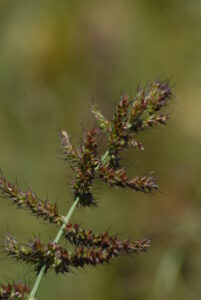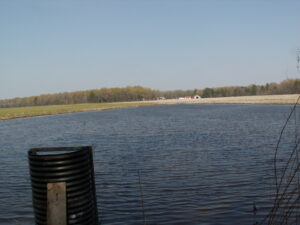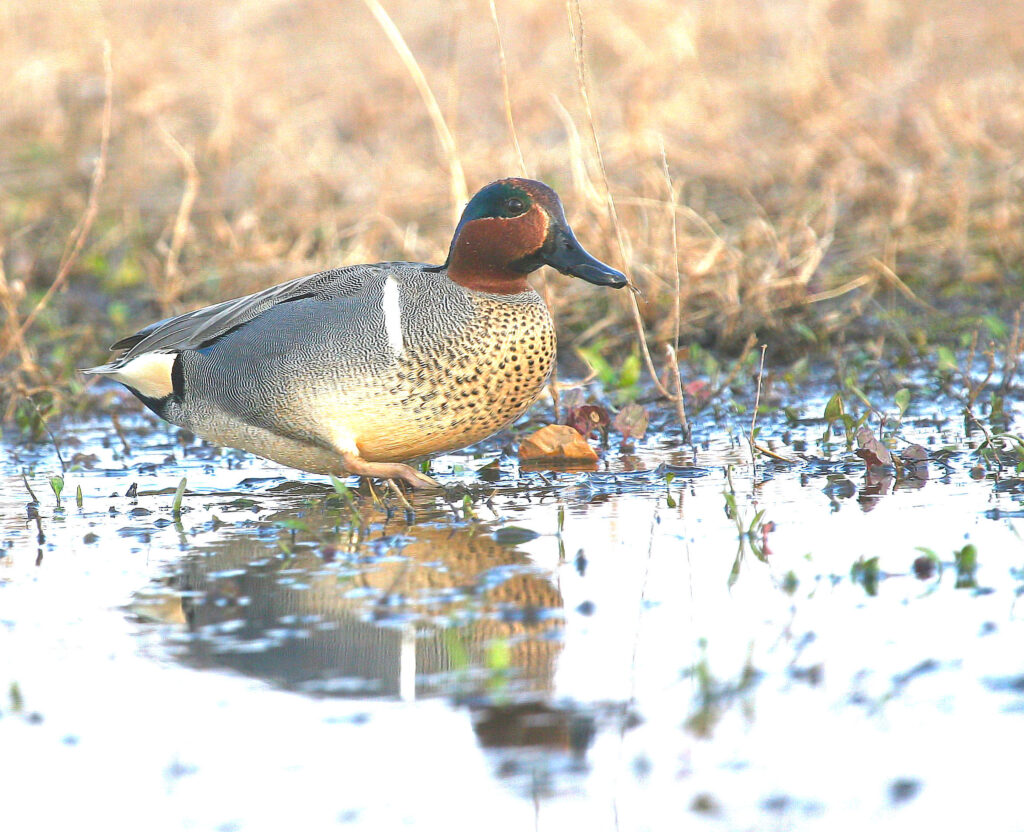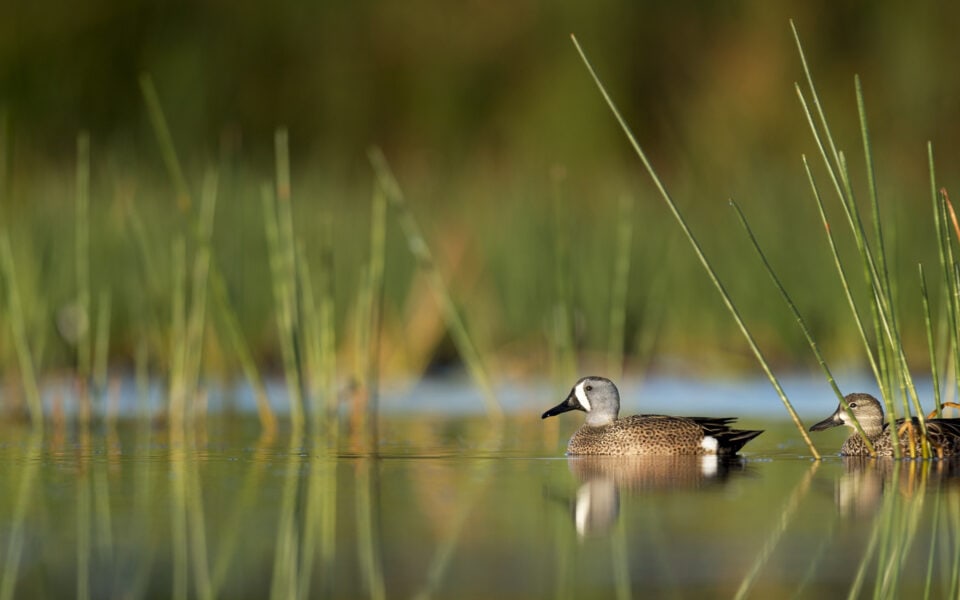The Deal With Teal
Over many parts of the eastern U.S., early September means dove hunting and for some waterfowl hunters, it’s also time to take advantage of the early teal season. The special teal season we are all familiar with started as an experimental season in 1965-67 in the Mississippi and Central Flyways. The early season then became an option for other states in 1969. Although the early season was closed for a short period of time during the 1970s when waterfowl populations were showing a decline, it has been in place for over 50 years. Over the years states have implemented a range of options depending on overall waterfowl numbers and interest among hunters.
The overall goal of the experimental season was to allow waterfowl hunters an opportunity to harvest a portion of early migrating “blue-winged teal” that typically do not winter in the United States during normal waterfowl hunting seasons. True, some blue-winged teal or “blue-wings” as I like to call them, do spend the winters in South Louisiana, or South Florida, and I have shot some in Tennessee during the early fall season, but cold weather pushed them south in a hurry.
Prior to fall migration, blue-winged teal have just wrapped up their summer molt. This annual event leaves blue-wings totally flightless for about 26-36 days. During the molt, females continue taking care of broods while the males separate to feed exclusively at night and hide out during the day under any cover they can locate across the almost treeless habitat. As birds regain flight feathers, it is generally small groups of males that begin the fall migration that can cover two continents.

Several years ago, I was visiting Puerto Rico and had the opportunity to visit one of the Territorial Wildlife Management Areas. Blue-winged teal were in good numbers, making it obvious these small ducks were capable of long flights from the Dakotas and other regions in the northern prairies. Blue-wings are very common during the winter months in Mexico, Cuba, Central America, and Venezuela and there is little doubt they are the “long haul travelers” of our American waterfowl.
During both the spring and fall migrations, one thing you can say, blue-winged teal are prompt. I used to tell folks you can almost set your watch to when they arrive each fall. Their migration dates seem fairly consistent. If waterfowl hunters have not thought about hunting yet, the arrival of blue-wing teal each fall seems to get hunters cranked up and thinking about preparing decoys and fine-tuning retrievers for the upcoming season.
Many states provide waterfowl hunters opportunities to harvest this early migrant duck and depending on your location in the country, or which flyway you hunt, you can count on seeing blue-winged teal arriving August throughout October.
Most early teal seasons are scheduled for September and if you have never taken advantage of this season, plan on taking mosquito spray, plenty of drinking water, and camo T-shirts. Additionally, gamekeepers should take some time to manage a piece of ground for this warm season hunt, because with some management and planning you may be able to enhance a small impoundment to grab a few days of great early hunting.
Again, depending on your location you will probably see three species of ducks showing up in your early decoy spread including wood ducks, blue-winged teal, and green-winged teal. You may also see cinnamon teal if you’re lucky.
I generally see both species of teal together, with wood ducks showing up in separate flights. A general rule of thumb and a guesstimate is that about eighty percent of the early season teal arriving in your decoy spread will be blue-wings. The remaining twenty percent of the flight are likely going to be green-winged teal. Green-wings tend to migrant later. Common sense would agree with science in this case, and the reason being; green-wings are a little more tolerating of cold weather than blue-wings. This is also one of the reasons blue-wings seem to migrate earlier and farther, taking many of them into the tropics each winter.
Another item I have noticed over the years; the two species of teal tend to select different habitat types throughout the year. Bluewings prefer more open areas while green-wings will spend more time in brushy areas or sites with woody cover along the shoreline.

I asked Mississippi State University Wildlife Professor Dr. Brian Davis, about some of these differences in teal. Dr. Davis said, “Teal tend to select habitat similar to their breeding habitat.” Dr. Davis said, “think about where blue-winged teal and green-winged teal nest, it’s two entirely different types of habitat. ” Bluewings nest in the “Prairie Pothole Region” an area that is predominately grasslands with few trees surrounding nest sites which is why blue-wings will tend to select this habitat type.
On the other extreme are green-winged teal. Green-wings nest in the Boreal Forest Region across a large section of Canada. The Boreal Forest Region is characterized by forested shorelines. Ponds and lakes are generally small and narrow, and the wetlands they use for nesting have numerous scattered shrubs.
In most situations, these habitat characteristics are directly responsible for which sites the two-teal species will choose during migration. Given the choice, it appears Green-wings will drop into beaver ponds, openings in green-tree reservoirs, or buttonbush thickets you might find in the back of lakes or ponds.
Davis said, “The vegetation (in the south) is obviously different, but it is physically the same environment”. Even if there is no appreciable food on-site, birds are still looking for roosting or loafing sites that resemble their preferred habitat. Keep this in mind when you are planning to set up a site for early teal hunting.
So, what can you do to attract birds during the early season? Davis said, “Blue-winged teal have such a wide variety of habitat types across the country and their diet is so broad, just about any wetland can produce food for blue-winged teal”. The foods blue-wings eat include animal matter primarily invertebrates, such as insect larvae, small snails, freshwater shrimp, and clams. The plant matter in their diet is predominantly seeds. Davis said, “when I was working in Missouri on waterfowl areas, we had mudflats with maybe an inch of water with a mixture of moist plants around it…the teal just rolled in on this field.”
If you manage waterfowl, and/or read about water-fowl management, you have heard about “moist soil management.” Briefly – this drawdown of water in an impoundment creates a mudflat during the spring or early summer. The exposed mudflat allows native plants such as smartweed or sedges to germinate. As the plants begin growing the site may be periodically reflooded to help increase seed production. In the fall, the site is then flooded to attract waterfowl.
Occasionally moist soil management requires late summer disking or mowing. In most cases, this will not provide enough time for plants to mature prior to the first frost, but the technique is sometimes necessary for weed control or even preparing the ground for next year’s crop. If you have impoundments with independent flooding and drawdown capabilities these are perfect locations for short-duration flooding of new mudflats. Simply adding some shallow water is an easy task for attracting early September teal.

If impoundments are scheduled for November flooding, you might consider only partially flooding an impoundment for teal. Put a little water in early, keep it shallow and then do a drawdown before plants begin to deteriorate.
Overall, blue-winged teal will consume any small seeds such as panic grass, wild millet, rice, teal grass, and all of these are a major part of their diets – keep this in mind when flooding impoundments. One seed that seems to provide a real enticement are any of the species of smartweeds with sedges running a close second. The key ingredient is adding an inch or so of water.
Although there are slight differences between the blue-winged teal and green-winged teal, Steven P. Havera’s book Waterfowl of Illinois provides a good comparison. Havera indicated “Even though blue-wing and green-winged teal feed together in marshes and mudflats, their diets differ in proportions of plant and animal matter.” From the standpoint of a gamekeeper, management need not differ for each species. The secret is having a good mix of planted foods like Japanese millet and native moist-soil plants.
If you are planning on hunting your impoundments during waterfowl season, don’t flood the entire impoundment, except for a few days. Once you flood, plants may begin deteriorating so keep a check on them, so they will be available during the regular waterfowl season. By slowly raising or lowering water levels you are mimicking a late summer flood event. Most wetland plants can tolerate a temporary late flood. Shallow water is an important management tool for teal.
Making plantings specifically for teal should include Japanese millet. This species will attract both teal but also plan on having a good selection of moist-soil plants including Pennsylvania smartweed, barnyard grass, curl top lambs quarter, flatsedge, and spike rushes. This list varies according to your geographic location.
Green-winged teal have a very diversified diet. Except for spring, diets of blue-wings are more herbaceous. In the spring all waterfowl feed almost exclusively on invertebrates. Blue-wings will utilize aquatic vegetation and they may even consume algae, but for the most part, they are focused on seeds if there is shallow water.
It’s slightly different for green-wings as they might feed in cornfields with mallards. Davis said, “You will see green-wings out on the high plains of the Texas Panhandle feeding on corn fields during the cold weather.” This also demonstrates how green-wings are more resilient to cold than blue-wings.
When getting things ready for the opening day of teal season, be prepared for anything because Davis described how unpredictable blue-winged teal can be. “Even when you have the “table set” one group of hunters may smoke teal and another group may never fire a shot.” Two days later it might be the opposite. Like all waterfowl, local conditions can influences hunting.
While gamekeepers may be primarily concerned about getting the table set for early fall, why not consider providing some assistance to the birds during the spring migration as well. Their needs are as great during the spring as in the fall. The job is similar except in reverse.

Spring finds the birds needing invertebrates. These provide high protein needed for nesting and reproduction. A general rule finds that the spring diet of blue-winged teal is about thirty-five percent plant matter and sixty-five percent invertebrates. Just as in the fall, shallow water and drawdowns are important for teal as this will tend to concentrate invertebrates that migrating birds can take advantage of. Spring drawdowns should be slow with a drawdown rate of 2-4 inches per day. In most cases, this will also coincide with normal moist soil management needed to provide waterfowl food the following fall.
The good thing about blue-winged teal, they are accustomed to migrating in the driest time of the year and they will quickly utilize any shallow body of water along the fall migration route. It’s also a good bet that providing some stop-overs in the spring might provide an invitation to imprint for a future fall stopover as well, hopefully increasing hunting success. Don’t overlook planting some millet in a partially dried up beaver pond and in the past, I have shot teal around farm ponds with mud edges.
Hunting is sometimes a hit-and-miss hunt. You might see teal, or you may not. If you are hunting them, don’t worry too much about gear. Two dozen decoys might be too many and what you can carry in a small bag, six to ten is about right. September hunting can be warm, so light camo is a must. If you don’t have any large impoundments on your land, consider setting up along creeks or rivers. Find a sandbar in a bend where birds can sight in on a small decoy spread. In any case, with some planning, the early teal season is a great way to break in the dog, shake the dust off some decoys and look forward to another waterfowl season.






